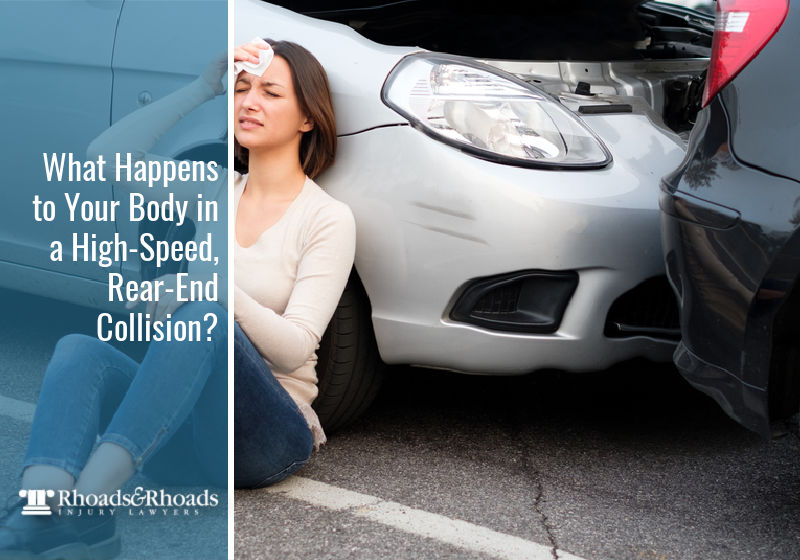
A person can sustain an injury from a car accident regardless of the car’s speed at the time of the collision. However, high-speed car accidents are often traumatic and, tragically, too often fatal. After surviving a high-speed car accident, it can take weeks, months, or even years to recover from your injuries. Some of those injuries may even be permanent. Understanding what happens to your body in a high speed rear-end collision can help you cope with your injuries and get the treatment and compensation you need.
If you have experienced short or long-term impacts of a rear-end car crash, it is imperative that you reach out to a knowledgeable and experienced car accident attorney, like the team at Rhoads & Rhoads, to learn about your rights.
Common Car Accident Injuries
Let’s take a look at some common car crash injuries that are likely to occur in a high-speed collision.
Damage to Internal Organs
Following an accident, your organs are likely to be bruised and swollen. They can also be penetrated by foreign objects or broken ribs, causing major damage to internal organs.
The physical force of the crash can send your internal organs slamming forward into your rib cage. The organs that are commonly injured in high-speed accidents include the liver, spleen, kidneys, lungs, and even the heart.
A serious internal organ car accident injury that can occur is a rupturing of the bowels. When the intestines are torn, pierced, or otherwise stressed by injury, bile and bodily waste can leak into your torso, causing serious infection, including sepsis and death.
Broken and Fractured Bones
The force of a car accident can also break your bones. Your seatbelt, assuming you are wearing one, stops your body from continuing to fly forward. This impact can lead to the fracture of bones such as your ribs, clavicle, or pelvis.
If any part of your body strikes the dash or the seat in front of you, you may be left with broken arms, wrists, legs, shoulders, ankles, etc.
If you are not wearing a seatbelt, you are far more likely to experience broken bones from the impact of hitting the windshield, the hood of the car, or even the pavement of the road.
Seatbelt Injuries
Wearing a seatbelt is vital to protect the body during a car crash. However, passengers and drivers alike may suffer from seatbelt injuries following an accident.
When your seatbelt stops your body from flying through the windshield, you may have a broken collarbone or extreme bruising from your seatbelt. When one or both cars are traveling at a high rate of speed, seatbelt injuries are more likely to be significant. Still, it is better to deal with a broken collarbone or bruised ribs than to be killed because you weren’t belted properly.
Brain Injuries
Head, brain, and skull injuries occur in high-speed accidents because of the way your head is whipped back and forth during the collision.
Even if your head does not hit anything like the steering wheel or airbag, the rapid movement of your brain inside of your skull can lead to a serious concussion.
Traumatic brain injuries (TBIs) can have lifelong implications, including memory problems, headaches, migraines, seizures, dizziness, nausea, visual changes, fatigue, paralysis, problems with balance, mood swings, and more.
Damage to Soft Tissue
A soft tissue injury is any injury that affects your muscular system, ligaments, or tendons.
An accident causes the soft tissue to stretch too far too quickly, and in ways that are unnatural for your body. This can lead to prolonged pain, soreness, and stiffness. Sometimes torn and injured soft tissue needs surgical repair.
Shock
Shock is a medical condition that is caused by a sudden and dangerous drop in blood flow. It can be the result of trauma, blood loss from an injury or severe burns, as well as several other emergency events.
Shock may lead you to experience delayed pain from the accident, as adrenaline and other endorphins may cause your brain to ignore your injuries until later. This is one of the reasons why you should always be evaluated by a doctor following an accident, even if you don’t initially think that you are injured.
Nerve Damage
Nerve damage, which is most typically associated with spinal injuries, can be the source of years of pain and frustration.
Damaged nerves can manifest in the form of shooting pain, radiating pain, tingling, numbness, and weakness.
Rear-End Collision Injuries
When you are hit in a car from behind, the momentum of the vehicle that struck you is transferred to your vehicle. This forces your car forward suddenly which in-turn causes your body to snap forward and back with excessive force. The speed of the vehicle that hit you determines the amount of force transferred to you, which is why high-speed rear-end collisions are so dangerous.
Whiplash and concussions are the most common injuries associated with rear-end collisions. While these may carry a stigma of being “simple” injuries, both can cause serious complications, especially when high rates of speed are involved.
After An Accident in Kentucky, You Need Support & Care
Knowing what happens to a body in a car crash may be a bit overwhelming. However, this knowledge can also help empower you to seek the care you need.
Following a car accident in Kentucky, legal counsel from Rhoads & Rhoads Attorneys at Law can help you figure out how to address current and future medical expenses, lost wages, housekeeping services, pain and suffering, and wrongful death claims.
You deserve a knowledgeable, experienced, and compassionate legal team to help navigate the effects of your accident. To schedule a free, no-obligation consultation, contact us online or call 888-709-9329.


